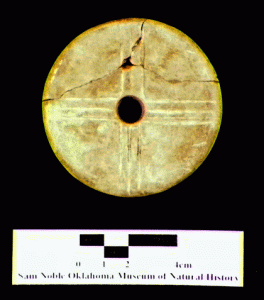Earspool – 34Lf40/555 (written by Laurel Lamb)
This artifact is a perforated pulley-shaped earspool with a carved hole in the center (Brown 1996:564). A variety of different types of earspools can be found at the archaeological collection at the Sam Noble Museum of Natural History, as well as many others in Spiro collections around the country. The variety of types and sheer amount of ear ornaments in existence support the idea that they were far from rare in Caddoan society. In fact, there is evidence of earspool usage across the Eastern Woodlands region during the Mississippian period (Brown 1996:563).

This particular earspool was made either from fine-grained siltstone or sandstone, though earspools were also made from other materials, such as wood and clay. Siltstone and sandstone are durable material, which is one reason why many earspools, such as this one, are still in such good condition (Sievert 2011:107). Often copper plates originally covered the front of earspools. Though none of the earspools at the Sam Noble Museum collection still have their copper plate covers, some do have leftover copper residue on them.
Despite its remarkable two and a half inch diameter, this earspool was actually able to be worn on people’s ears. The outer and inner flanges, which are the front and back sides of the earspool respectively, are separated by a carved out core area in between them. So, despite the large diameter of this artifact’s flanges, the diameter of the core was not as large. Appearances can be deceiving. However, it still would have been an amazing feat to be able to stretch an earlobe enough for this object to fit. Other evidence that earspools such as this one were actually worn lies on various pictorial decorations. Warriors with perforated pulley-shaped earspools can be seen on both decorated shell cups and copper plates (Brown 1996:561).
A cross within a circle is one of the most common decorations on earspools like this one (Brown 1996:566). In fact, it is a very common symbol found on a variety of different Spiro artifacts. Though the cross is not one of the most elaborate symbols found on artifacts, the symbolism behind it is nonetheless very significant for an understanding of Spiroan spiritual beliefs. This significance lies with F. Kent Reilly’s (2004:127-128) explanation of the Mississippian belief of a three level universe: the Above World, the Middle World, and the Beneath World. The Middle World, home to humans, was oriented by the cardinal and semi-cardinal directions. Residing in the Above World and Under World, various deities, such as a female lunar deity and a solar deity, were associated with specific cardinal directions. The earspool’s three parallel lines forming the cross perhaps signifies these three worlds connection with the cardinal directions. This connection might be of even greater importance since the earspool was excavated from the Great Mortuary mound, a place where death provoked thoughts about the other worlds in the Mississippian universe.
